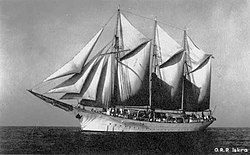Iskra (ship, 1917)
|
The Iskra in the early 1930s
|
||||||||||||||||||
|
||||||||||||||||||
|
||||||||||||||||||
|
||||||||||||||||||
|
||||||||||||||||||
The Iskra ( Polish for "spark" ) was a three - masted gaff schooner built in the Netherlands in 1917 , which first sailed the North Sea as a Dutch Vlissingen , then as a British St. Blane . In 1927 the ship was sold to Poland, where, with the exception of the period of World War II, it was used by the Polish Navy as a sailing training ship from 1928 to 1977 . In 1981 the ship was scrapped.
Construction and technical data
The Iskra was on 19 June 1917 in the Netherlands at the shipyard G. Muller in Foxhol under the name Vlissingen from the stack . The ship measured 500 tons or 373 GRT and was 50.70 meters long, 7.90 meters wide and 3.80 meters deep. A diesel engine supported the sailor. It produced 260 hp and acted on a screw. The crew consisted of 20 regular crew members and 30 cadets.
North Sea freighter Vlissingen and St. Blane
The Vlissingen was initially owned by the Zeevarts Maatschappie shipping company, which registered it in Groningen . As a cargo sailor, the ship was first used in the coastal trade in the Netherlands, and after the First World War also on the British coast and as far as London. It sailed under the Dutch flag until 1921, after which it was sold to Great Britain. In 1925 the shipping company A. Kennedy & Son bought the ship and named it St. Blane . This shipping company also continued to use the ship in coastal trading before selling it to the Polish government.
Training ship of the Second Polish Republic
On January 1, 1927, the ship was transferred to Poland and converted into a training ship for the Polish Navy in Gdansk at the Gdansk shipyard and railway workshops . For this purpose, two additional deckhouses were built for part of the crew. On May 6, 1928, the Polish flag was hoisted for the first time on the ship renamed ORP Iskra . The home port was Gdynia . In the following years the Iskra undertook training trips as a sailing training ship, mainly in the Baltic Sea, but also as far as the Mediterranean and the United States of America.
At the beginning of the Second World War, the Iskra was on its way to the Mediterranean. On September 2, 1939, she reached the port of Casablanca and on October 10, she and the Polish school transporter ORP Wilia put in Port Lyautey (today's Kenitra in Morocco). After France surrendered, Iskra was moved to Gibraltar on June 27, 1940 . There it was on loan from the Polish government in exile on November 29th by the British Navy , which used the ship as HMS Pigmy as a base for torpedo boats and submarines . In addition, it was largely dismantled. Already on March 31, 1941, she got her old name back and was first used as a residential ship, from August 11, 1941 as a depot ship. After the end of the war, the ship was returned to the Polish Navy, and on July 1, 1948, the Iskra returned to Gdynia.
Training ship of the People's Republic of Poland
Until 1974 the Polish Navy used the ship again as a training ship with a focus on the Baltic Sea and trips from the Barents Sea to the Mediterranean and Atlantic. It was then taken out of service due to wear and tear, but initially served as a Hulk in the Gdynia naval port . On November 26, 1977, the Iskra was finally removed from the fleet list of the Polish Navy. In total, she had covered 201,000 nautical miles under the Polish flag . In 1981 the ship was scrapped.
In 1982 the current sailing training ship of the Polish Navy received this name again.
Remarks
- ↑ Braynard, p. 72, Schäuffelen, p. 126
- ↑ Braynard, p. 72, Schäuffelen, p. 126
- ↑ Braynard, p. 72, Schäuffelen, p. 126
- ↑ ORP is the abbreviation for "Okręt Rzeczypospolitej Polskiej" and the name prefix of Polish ships. ORP means "Warship of the Republic of Poland".
- ↑ Piaskowski, p. 31, cf. http://www.zaglowce.ow.pl/polskie/iskra/index.html
- ↑ cf. Peszke, p. 78
- ↑ cf. http://www.naval-history.net/xDKWW2-4012-25DEC02.htm , Piaskowski, p. 29, Schäuffelen, p. 126
- ↑ http://uboat.net/forums/read.php?22,65555,65557,quote=1
- ↑ cf. http://www.zaglowce.ow.pl/polskie/iskra/index.html
Web links
- http://www.zaglowce.ow.pl/polskie/iskra/index.html (Polish), accessed on January 21, 2017
- http://uboat.net/forums/read.php?22,65555,65557,quote=1 , accessed on January 21, 2017
- http://www.shipspotting.com/gallery/photo.php?lid=313115 , accessed January 21, 2017
- http://www.naval-history.net , accessed on January 21, 2017
literature
- Otmar Schäuffelen: The last great sailing ships , Delius Klasing Verlag, Bielefeld 1977, ISBN 3-7688-0078-4
- Frank Osborn Braynard: The Tall Ships of Today in Photographs , Dover Publications, New York 1993, ISBN 978-0486271637 ( preview in Google Book Search, accessed January 21, 2017)
- Stanisław M. Piaskowski: Okręty Rzeczypospolitej Polskiej 1920-1946 [The Ships of the Republic of Poland 1920-1946] , Album Planów, Warsaw 1996, ISBN 83-900217-2-3
- Michael Alfred Peszke: Poland's Navy 1918-1945 , Hippocrene Books Inc., New York 1999, ISBN 0-7818-0672-0

